Leadership Essay: The Importance of Teamwork at Work
VerifiedAdded on 2021/02/20
|11
|1573
|22
Essay
AI Summary
This essay examines the critical role of teamwork in organizational success, emphasizing the importance of effective team building and leadership. It delves into how teamwork contributes to achieving common goals within an organization. The essay explores Belbin's team management theory, outlining various team roles and their significance in fostering collaboration and communication. It discusses action-oriented, people-oriented, and cerebral roles, providing insights into how team leaders can leverage these roles to enhance team performance. The conclusion highlights the importance of team building for organizational growth and sustainability, summarizing the key takeaways from the analysis of team dynamics and leadership strategies. The essay references several academic sources to support its arguments.
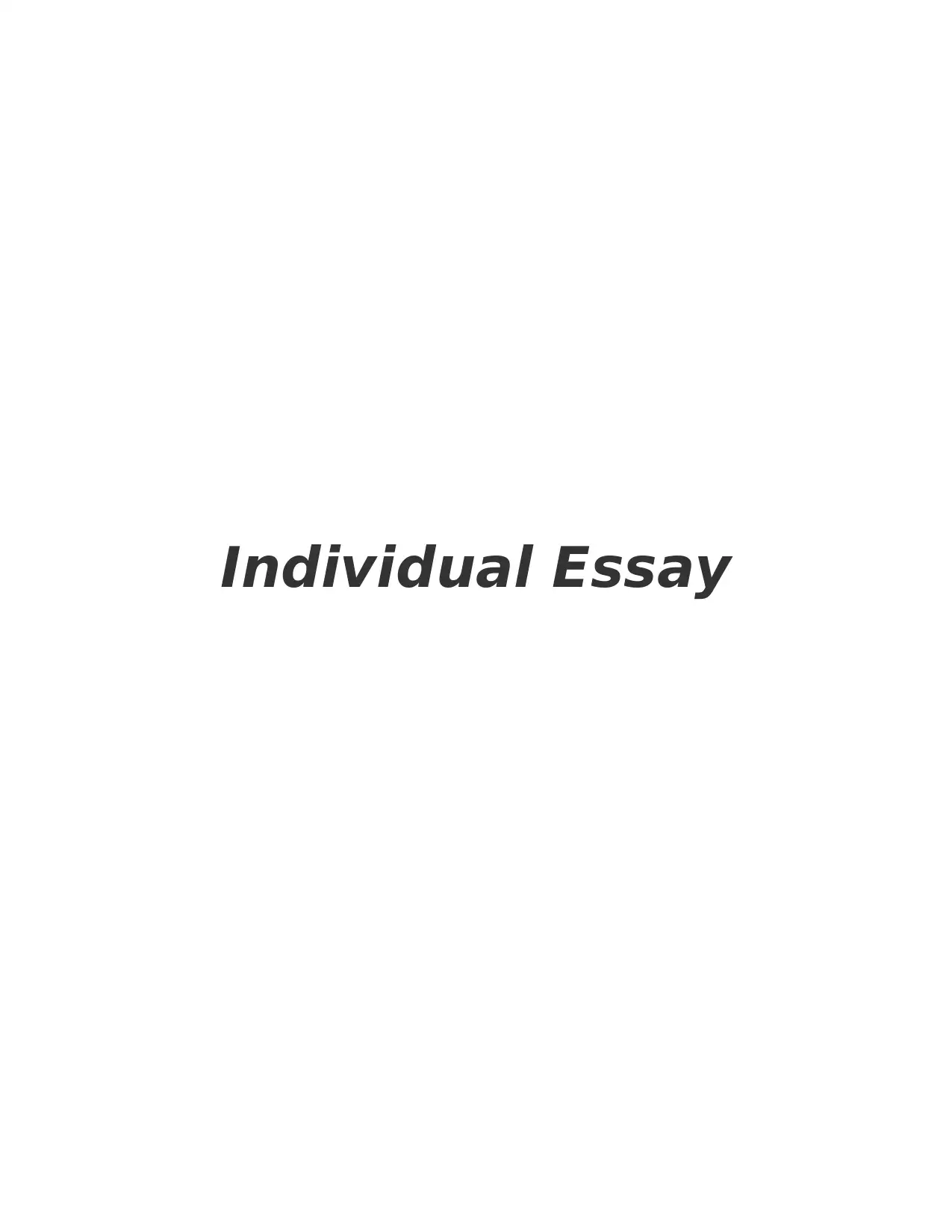
Individual Essay
Paraphrase This Document
Need a fresh take? Get an instant paraphrase of this document with our AI Paraphraser
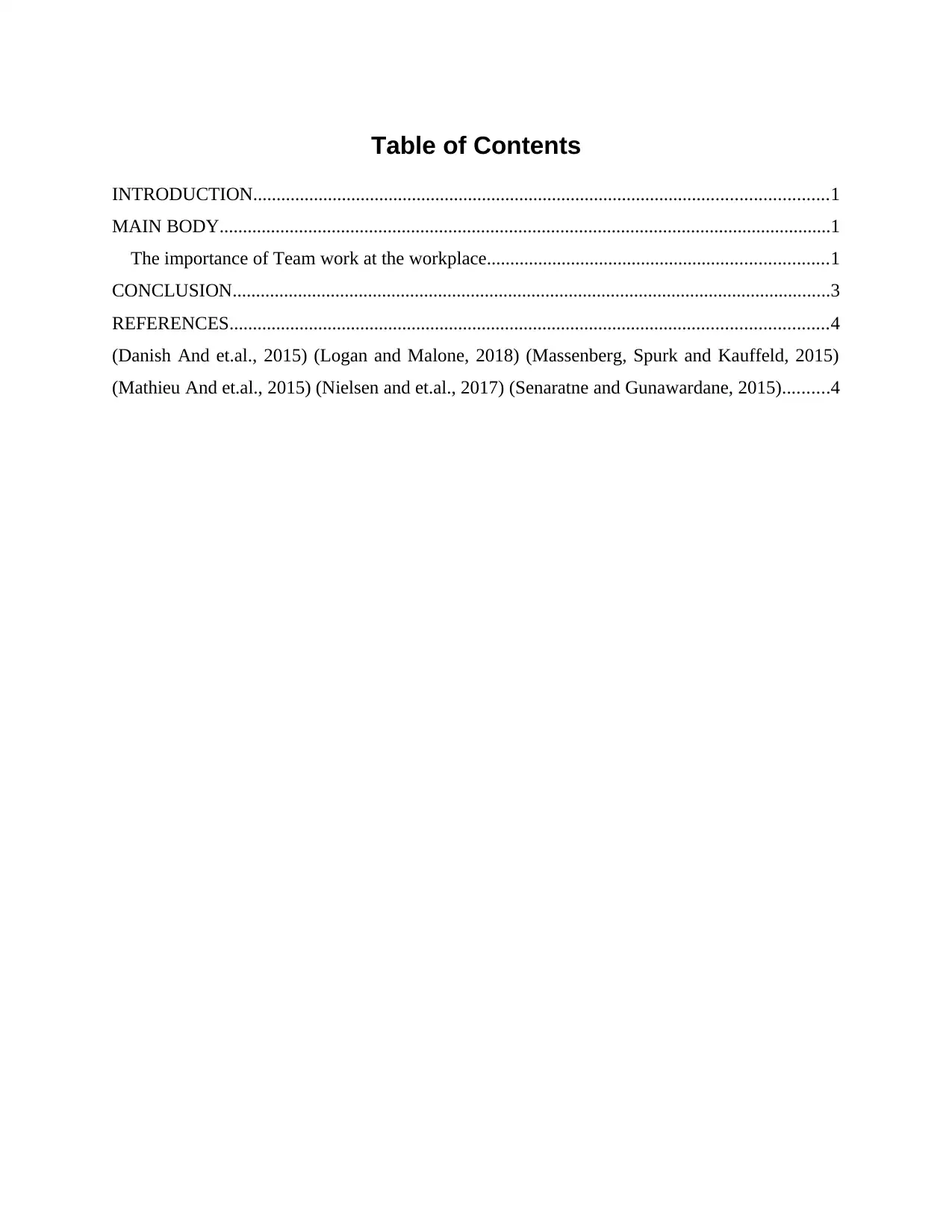
Table of Contents
INTRODUCTION...........................................................................................................................1
MAIN BODY...................................................................................................................................1
The importance of Team work at the workplace.........................................................................1
CONCLUSION................................................................................................................................3
REFERENCES................................................................................................................................4
(Danish And et.al., 2015) (Logan and Malone, 2018) (Massenberg, Spurk and Kauffeld, 2015)
(Mathieu And et.al., 2015) (Nielsen and et.al., 2017) (Senaratne and Gunawardane, 2015)..........4
INTRODUCTION...........................................................................................................................1
MAIN BODY...................................................................................................................................1
The importance of Team work at the workplace.........................................................................1
CONCLUSION................................................................................................................................3
REFERENCES................................................................................................................................4
(Danish And et.al., 2015) (Logan and Malone, 2018) (Massenberg, Spurk and Kauffeld, 2015)
(Mathieu And et.al., 2015) (Nielsen and et.al., 2017) (Senaratne and Gunawardane, 2015)..........4
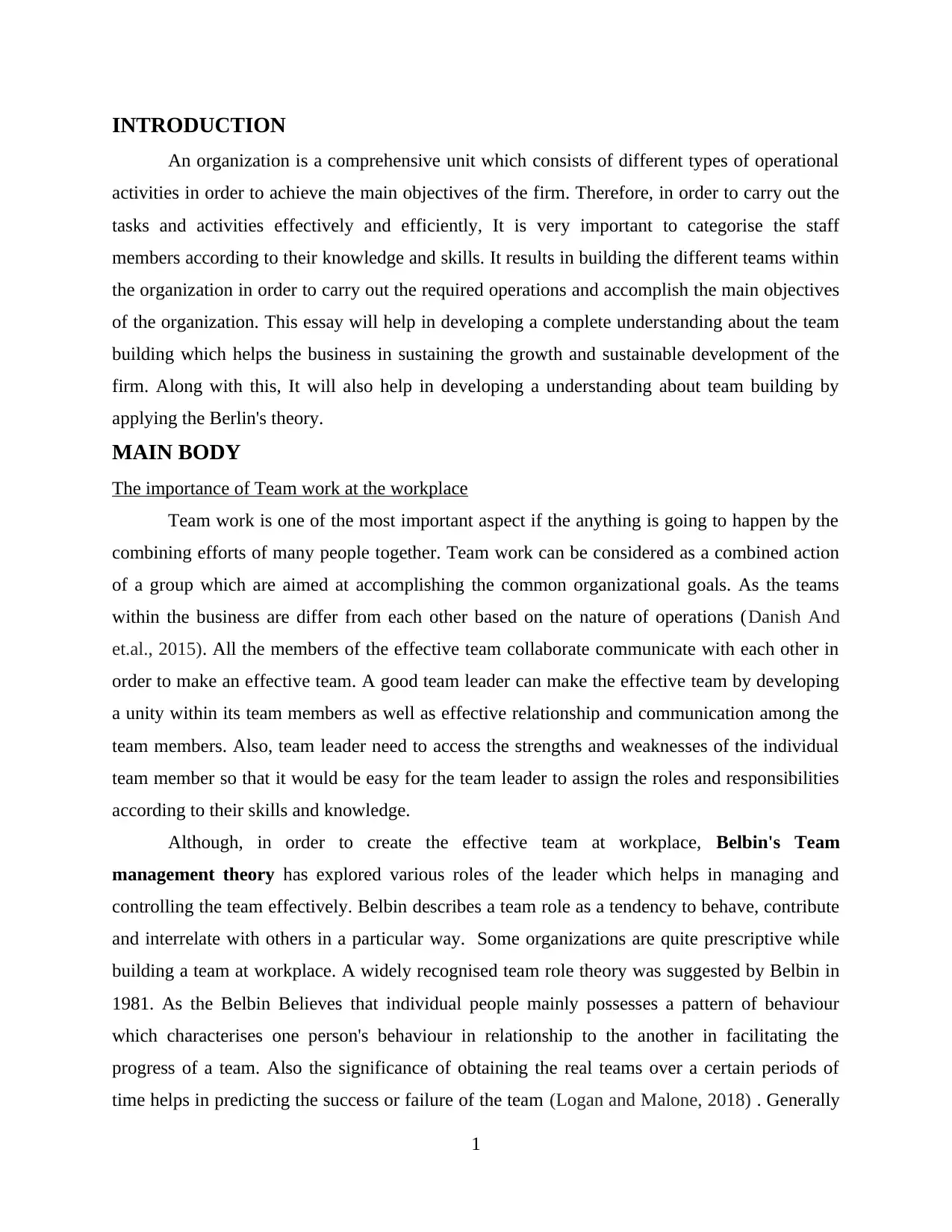
INTRODUCTION
An organization is a comprehensive unit which consists of different types of operational
activities in order to achieve the main objectives of the firm. Therefore, in order to carry out the
tasks and activities effectively and efficiently, It is very important to categorise the staff
members according to their knowledge and skills. It results in building the different teams within
the organization in order to carry out the required operations and accomplish the main objectives
of the organization. This essay will help in developing a complete understanding about the team
building which helps the business in sustaining the growth and sustainable development of the
firm. Along with this, It will also help in developing a understanding about team building by
applying the Berlin's theory.
MAIN BODY
The importance of Team work at the workplace
Team work is one of the most important aspect if the anything is going to happen by the
combining efforts of many people together. Team work can be considered as a combined action
of a group which are aimed at accomplishing the common organizational goals. As the teams
within the business are differ from each other based on the nature of operations (Danish And
et.al., 2015). All the members of the effective team collaborate communicate with each other in
order to make an effective team. A good team leader can make the effective team by developing
a unity within its team members as well as effective relationship and communication among the
team members. Also, team leader need to access the strengths and weaknesses of the individual
team member so that it would be easy for the team leader to assign the roles and responsibilities
according to their skills and knowledge.
Although, in order to create the effective team at workplace, Belbin's Team
management theory has explored various roles of the leader which helps in managing and
controlling the team effectively. Belbin describes a team role as a tendency to behave, contribute
and interrelate with others in a particular way. Some organizations are quite prescriptive while
building a team at workplace. A widely recognised team role theory was suggested by Belbin in
1981. As the Belbin Believes that individual people mainly possesses a pattern of behaviour
which characterises one person's behaviour in relationship to the another in facilitating the
progress of a team. Also the significance of obtaining the real teams over a certain periods of
time helps in predicting the success or failure of the team (Logan and Malone, 2018) . Generally
1
An organization is a comprehensive unit which consists of different types of operational
activities in order to achieve the main objectives of the firm. Therefore, in order to carry out the
tasks and activities effectively and efficiently, It is very important to categorise the staff
members according to their knowledge and skills. It results in building the different teams within
the organization in order to carry out the required operations and accomplish the main objectives
of the organization. This essay will help in developing a complete understanding about the team
building which helps the business in sustaining the growth and sustainable development of the
firm. Along with this, It will also help in developing a understanding about team building by
applying the Berlin's theory.
MAIN BODY
The importance of Team work at the workplace
Team work is one of the most important aspect if the anything is going to happen by the
combining efforts of many people together. Team work can be considered as a combined action
of a group which are aimed at accomplishing the common organizational goals. As the teams
within the business are differ from each other based on the nature of operations (Danish And
et.al., 2015). All the members of the effective team collaborate communicate with each other in
order to make an effective team. A good team leader can make the effective team by developing
a unity within its team members as well as effective relationship and communication among the
team members. Also, team leader need to access the strengths and weaknesses of the individual
team member so that it would be easy for the team leader to assign the roles and responsibilities
according to their skills and knowledge.
Although, in order to create the effective team at workplace, Belbin's Team
management theory has explored various roles of the leader which helps in managing and
controlling the team effectively. Belbin describes a team role as a tendency to behave, contribute
and interrelate with others in a particular way. Some organizations are quite prescriptive while
building a team at workplace. A widely recognised team role theory was suggested by Belbin in
1981. As the Belbin Believes that individual people mainly possesses a pattern of behaviour
which characterises one person's behaviour in relationship to the another in facilitating the
progress of a team. Also the significance of obtaining the real teams over a certain periods of
time helps in predicting the success or failure of the team (Logan and Malone, 2018) . Generally
1
⊘ This is a preview!⊘
Do you want full access?
Subscribe today to unlock all pages.

Trusted by 1+ million students worldwide
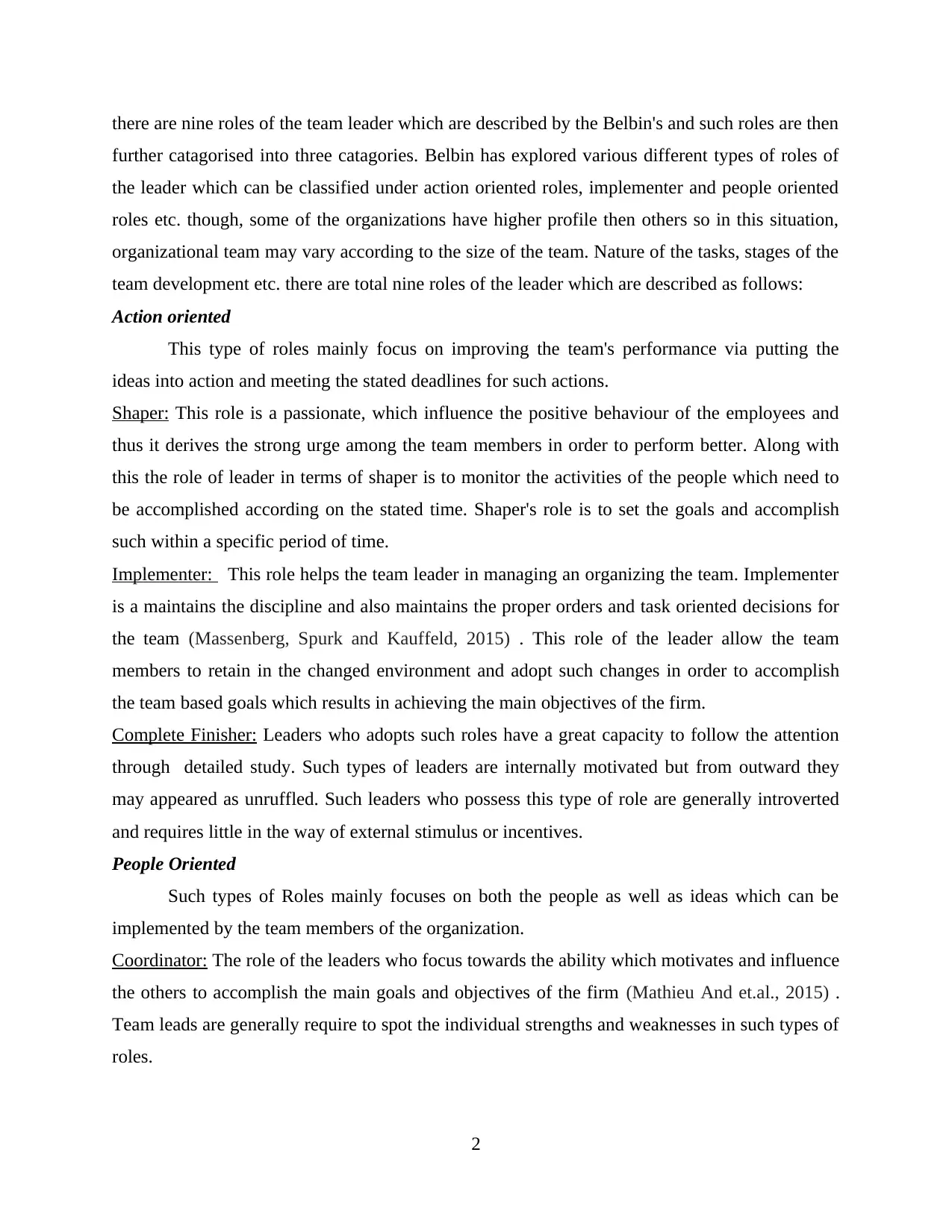
there are nine roles of the team leader which are described by the Belbin's and such roles are then
further catagorised into three catagories. Belbin has explored various different types of roles of
the leader which can be classified under action oriented roles, implementer and people oriented
roles etc. though, some of the organizations have higher profile then others so in this situation,
organizational team may vary according to the size of the team. Nature of the tasks, stages of the
team development etc. there are total nine roles of the leader which are described as follows:
Action oriented
This type of roles mainly focus on improving the team's performance via putting the
ideas into action and meeting the stated deadlines for such actions.
Shaper: This role is a passionate, which influence the positive behaviour of the employees and
thus it derives the strong urge among the team members in order to perform better. Along with
this the role of leader in terms of shaper is to monitor the activities of the people which need to
be accomplished according on the stated time. Shaper's role is to set the goals and accomplish
such within a specific period of time.
Implementer: This role helps the team leader in managing an organizing the team. Implementer
is a maintains the discipline and also maintains the proper orders and task oriented decisions for
the team (Massenberg, Spurk and Kauffeld, 2015) . This role of the leader allow the team
members to retain in the changed environment and adopt such changes in order to accomplish
the team based goals which results in achieving the main objectives of the firm.
Complete Finisher: Leaders who adopts such roles have a great capacity to follow the attention
through detailed study. Such types of leaders are internally motivated but from outward they
may appeared as unruffled. Such leaders who possess this type of role are generally introverted
and requires little in the way of external stimulus or incentives.
People Oriented
Such types of Roles mainly focuses on both the people as well as ideas which can be
implemented by the team members of the organization.
Coordinator: The role of the leaders who focus towards the ability which motivates and influence
the others to accomplish the main goals and objectives of the firm (Mathieu And et.al., 2015) .
Team leads are generally require to spot the individual strengths and weaknesses in such types of
roles.
2
further catagorised into three catagories. Belbin has explored various different types of roles of
the leader which can be classified under action oriented roles, implementer and people oriented
roles etc. though, some of the organizations have higher profile then others so in this situation,
organizational team may vary according to the size of the team. Nature of the tasks, stages of the
team development etc. there are total nine roles of the leader which are described as follows:
Action oriented
This type of roles mainly focus on improving the team's performance via putting the
ideas into action and meeting the stated deadlines for such actions.
Shaper: This role is a passionate, which influence the positive behaviour of the employees and
thus it derives the strong urge among the team members in order to perform better. Along with
this the role of leader in terms of shaper is to monitor the activities of the people which need to
be accomplished according on the stated time. Shaper's role is to set the goals and accomplish
such within a specific period of time.
Implementer: This role helps the team leader in managing an organizing the team. Implementer
is a maintains the discipline and also maintains the proper orders and task oriented decisions for
the team (Massenberg, Spurk and Kauffeld, 2015) . This role of the leader allow the team
members to retain in the changed environment and adopt such changes in order to accomplish
the team based goals which results in achieving the main objectives of the firm.
Complete Finisher: Leaders who adopts such roles have a great capacity to follow the attention
through detailed study. Such types of leaders are internally motivated but from outward they
may appeared as unruffled. Such leaders who possess this type of role are generally introverted
and requires little in the way of external stimulus or incentives.
People Oriented
Such types of Roles mainly focuses on both the people as well as ideas which can be
implemented by the team members of the organization.
Coordinator: The role of the leaders who focus towards the ability which motivates and influence
the others to accomplish the main goals and objectives of the firm (Mathieu And et.al., 2015) .
Team leads are generally require to spot the individual strengths and weaknesses in such types of
roles.
2
Paraphrase This Document
Need a fresh take? Get an instant paraphrase of this document with our AI Paraphraser
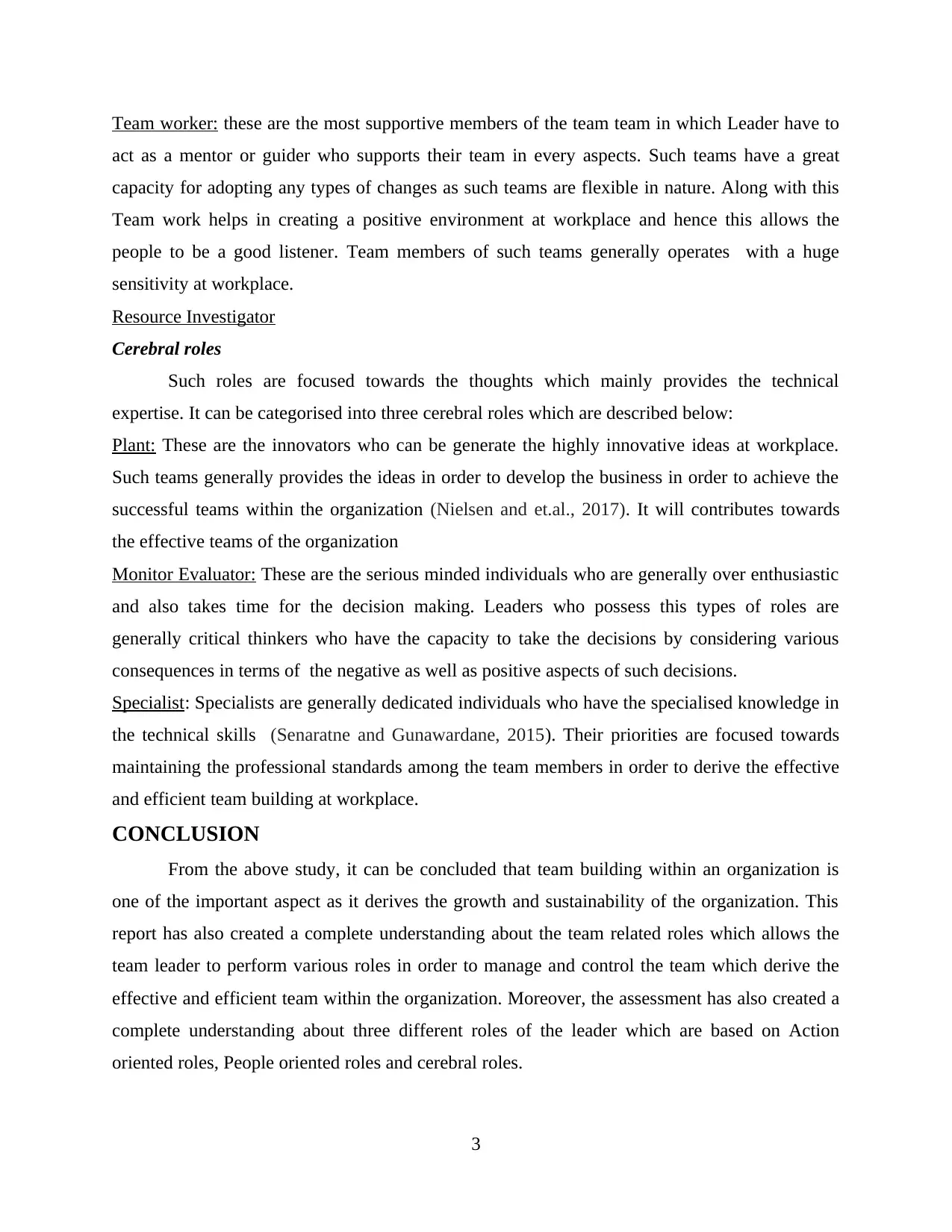
Team worker: these are the most supportive members of the team team in which Leader have to
act as a mentor or guider who supports their team in every aspects. Such teams have a great
capacity for adopting any types of changes as such teams are flexible in nature. Along with this
Team work helps in creating a positive environment at workplace and hence this allows the
people to be a good listener. Team members of such teams generally operates with a huge
sensitivity at workplace.
Resource Investigator
Cerebral roles
Such roles are focused towards the thoughts which mainly provides the technical
expertise. It can be categorised into three cerebral roles which are described below:
Plant: These are the innovators who can be generate the highly innovative ideas at workplace.
Such teams generally provides the ideas in order to develop the business in order to achieve the
successful teams within the organization (Nielsen and et.al., 2017). It will contributes towards
the effective teams of the organization
Monitor Evaluator: These are the serious minded individuals who are generally over enthusiastic
and also takes time for the decision making. Leaders who possess this types of roles are
generally critical thinkers who have the capacity to take the decisions by considering various
consequences in terms of the negative as well as positive aspects of such decisions.
Specialist: Specialists are generally dedicated individuals who have the specialised knowledge in
the technical skills (Senaratne and Gunawardane, 2015). Their priorities are focused towards
maintaining the professional standards among the team members in order to derive the effective
and efficient team building at workplace.
CONCLUSION
From the above study, it can be concluded that team building within an organization is
one of the important aspect as it derives the growth and sustainability of the organization. This
report has also created a complete understanding about the team related roles which allows the
team leader to perform various roles in order to manage and control the team which derive the
effective and efficient team within the organization. Moreover, the assessment has also created a
complete understanding about three different roles of the leader which are based on Action
oriented roles, People oriented roles and cerebral roles.
3
act as a mentor or guider who supports their team in every aspects. Such teams have a great
capacity for adopting any types of changes as such teams are flexible in nature. Along with this
Team work helps in creating a positive environment at workplace and hence this allows the
people to be a good listener. Team members of such teams generally operates with a huge
sensitivity at workplace.
Resource Investigator
Cerebral roles
Such roles are focused towards the thoughts which mainly provides the technical
expertise. It can be categorised into three cerebral roles which are described below:
Plant: These are the innovators who can be generate the highly innovative ideas at workplace.
Such teams generally provides the ideas in order to develop the business in order to achieve the
successful teams within the organization (Nielsen and et.al., 2017). It will contributes towards
the effective teams of the organization
Monitor Evaluator: These are the serious minded individuals who are generally over enthusiastic
and also takes time for the decision making. Leaders who possess this types of roles are
generally critical thinkers who have the capacity to take the decisions by considering various
consequences in terms of the negative as well as positive aspects of such decisions.
Specialist: Specialists are generally dedicated individuals who have the specialised knowledge in
the technical skills (Senaratne and Gunawardane, 2015). Their priorities are focused towards
maintaining the professional standards among the team members in order to derive the effective
and efficient team building at workplace.
CONCLUSION
From the above study, it can be concluded that team building within an organization is
one of the important aspect as it derives the growth and sustainability of the organization. This
report has also created a complete understanding about the team related roles which allows the
team leader to perform various roles in order to manage and control the team which derive the
effective and efficient team within the organization. Moreover, the assessment has also created a
complete understanding about three different roles of the leader which are based on Action
oriented roles, People oriented roles and cerebral roles.
3

4
⊘ This is a preview!⊘
Do you want full access?
Subscribe today to unlock all pages.

Trusted by 1+ million students worldwide
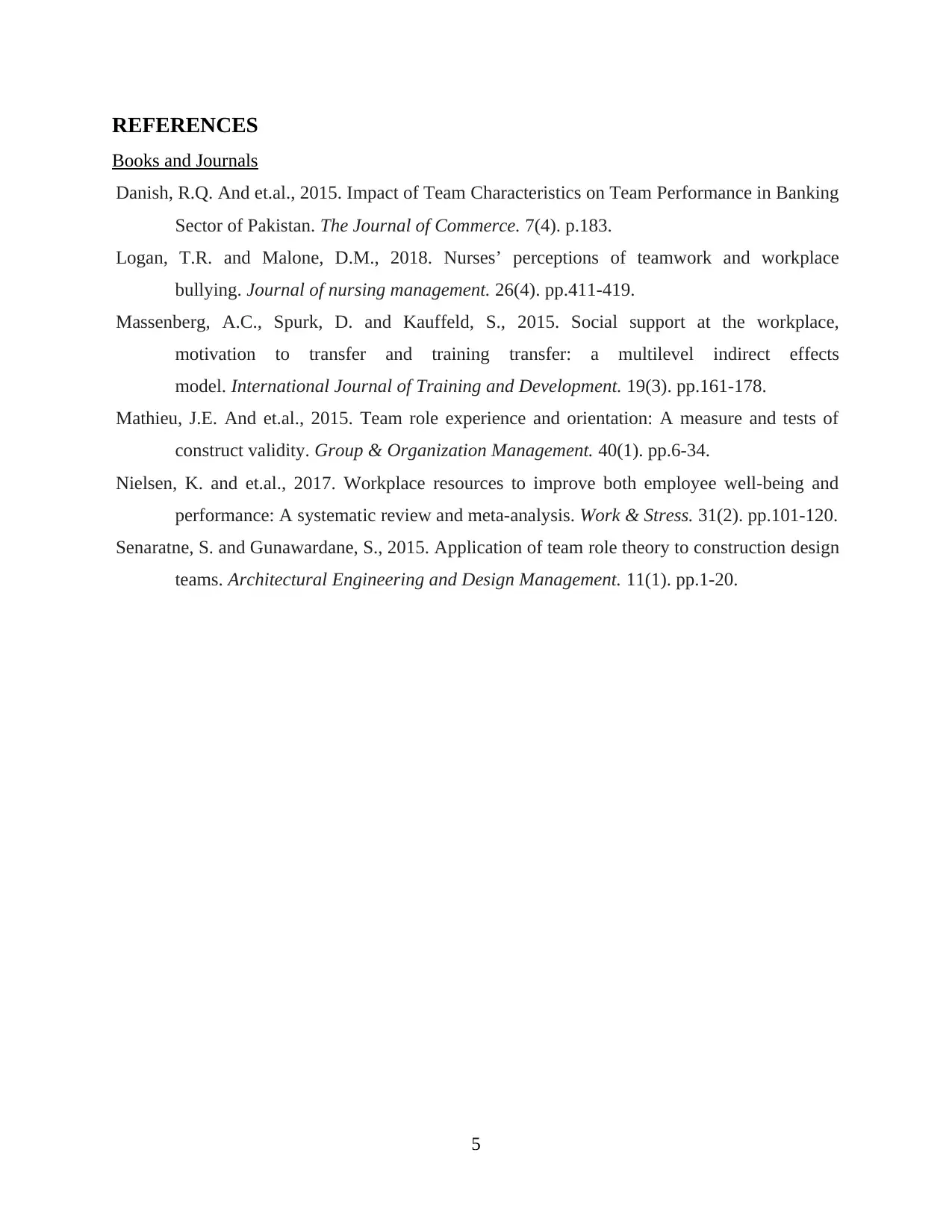
REFERENCES
Books and Journals
Danish, R.Q. And et.al., 2015. Impact of Team Characteristics on Team Performance in Banking
Sector of Pakistan. The Journal of Commerce. 7(4). p.183.
Logan, T.R. and Malone, D.M., 2018. Nurses’ perceptions of teamwork and workplace
bullying. Journal of nursing management. 26(4). pp.411-419.
Massenberg, A.C., Spurk, D. and Kauffeld, S., 2015. Social support at the workplace,
motivation to transfer and training transfer: a multilevel indirect effects
model. International Journal of Training and Development. 19(3). pp.161-178.
Mathieu, J.E. And et.al., 2015. Team role experience and orientation: A measure and tests of
construct validity. Group & Organization Management. 40(1). pp.6-34.
Nielsen, K. and et.al., 2017. Workplace resources to improve both employee well-being and
performance: A systematic review and meta-analysis. Work & Stress. 31(2). pp.101-120.
Senaratne, S. and Gunawardane, S., 2015. Application of team role theory to construction design
teams. Architectural Engineering and Design Management. 11(1). pp.1-20.
5
Books and Journals
Danish, R.Q. And et.al., 2015. Impact of Team Characteristics on Team Performance in Banking
Sector of Pakistan. The Journal of Commerce. 7(4). p.183.
Logan, T.R. and Malone, D.M., 2018. Nurses’ perceptions of teamwork and workplace
bullying. Journal of nursing management. 26(4). pp.411-419.
Massenberg, A.C., Spurk, D. and Kauffeld, S., 2015. Social support at the workplace,
motivation to transfer and training transfer: a multilevel indirect effects
model. International Journal of Training and Development. 19(3). pp.161-178.
Mathieu, J.E. And et.al., 2015. Team role experience and orientation: A measure and tests of
construct validity. Group & Organization Management. 40(1). pp.6-34.
Nielsen, K. and et.al., 2017. Workplace resources to improve both employee well-being and
performance: A systematic review and meta-analysis. Work & Stress. 31(2). pp.101-120.
Senaratne, S. and Gunawardane, S., 2015. Application of team role theory to construction design
teams. Architectural Engineering and Design Management. 11(1). pp.1-20.
5
Paraphrase This Document
Need a fresh take? Get an instant paraphrase of this document with our AI Paraphraser

6

7
⊘ This is a preview!⊘
Do you want full access?
Subscribe today to unlock all pages.

Trusted by 1+ million students worldwide

8
Paraphrase This Document
Need a fresh take? Get an instant paraphrase of this document with our AI Paraphraser

9
1 out of 11
Related Documents
Your All-in-One AI-Powered Toolkit for Academic Success.
+13062052269
info@desklib.com
Available 24*7 on WhatsApp / Email
![[object Object]](/_next/static/media/star-bottom.7253800d.svg)
Unlock your academic potential
Copyright © 2020–2025 A2Z Services. All Rights Reserved. Developed and managed by ZUCOL.





